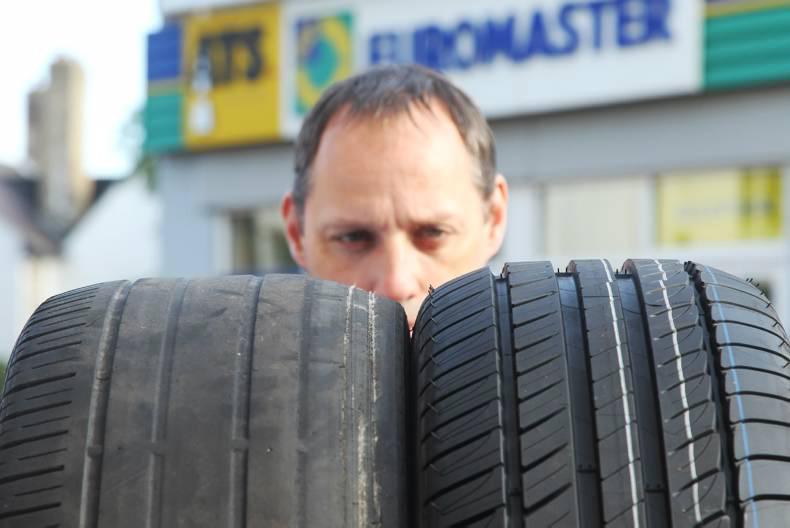Former Minister for Transport, Tourism and Sport Paschal Donohoe TD announced a Fixed Charge Notice (FCN) offence for motorists who drive with defective or worn tyres.
Although it is already an offence to drive a vehicle with defective or worn tyres, there will now be a fixed charge (or fine) of €80, with two penalty points endorsed on the licence on payment of the fixed charge for commission of the offence, or four penalty points following conviction in court.
The new regulations took effect from Sunday 17 April. The Road Safety Authority (RSA) believes the measure will promote greater awareness of the hazards of driving with tyres that are not in roadworthy condition.
Recently, the RSA reported that vehicle factors played a role in one in eight fatal collisions between 2008 and 2012. Defective tyres were the most significant factor, representing almost two thirds of all vehicle factors identified as contributing to a collision and to the deaths of 71 people on Irish roads in the past five years.
The RSA report also highlighted how important it is that every aspect of a vehicle is in proper roadworthy condition.
As a driver it is your personal responsibility to ensure your vehicle is properly maintained and that its tyres can reliably respond to whatever conditions you may encounter.
If you drive with damaged or worn tyres, you are putting your own life and the lives of others at risk. You also risk prosecution. If you are convicted of the offence of driving with dangerous tyres, you could be fined up to €2,500, or receive a three-month prison sentence, or both. You will also have five penalty points on your licence on conviction.
Tyre safety checks
It only takes a few minutes to complete the following three key tyre safety checks. For all drivers this is something we should get into the habit of doing at least once a month.
1 Inspect the general condition of each tyre to ensure they are free from bulges, lumps and cuts. Also any foreign objects embedded in the tread, such as stones, should be removed.
2 Check tyre pressures to ensure they are inflated to the vehicle manufacturer’s recommended settings. This information can be found in the vehicle handbook, inside the fuel filler cap or on a plate on the driver’s door sill.
3 Check the condition of the wheel rims. Tyre pressure loss may be due to air escaping from cracked wheel rims that have been damaged by driving over potholes.
4 Examine tread depths to ensure they exceed the minimum legal tread depth of 1.6mm across the central three quarters of the tyre, around its entire circumference.
The legal minimum limit for tyre tread depth in Ireland is 1.6mm. This is due to the fact that tyre performance, particularly in wet weather, gets worse as the tread wears down.
The greater the wear to your tyres the worse its wet weather grip will be. Tread depth should be checked more frequently once it reaches 3mm.
Tyres should be replaced before their tread depth wears below 2mm. This is especially important if heading into autumn and winter months.
Tyre attention
Driving a car with underinflated tyres makes it more difficult to control the vehicle, and can be the cause of a significant road collision. Lower tyre pressure also increases the distance it will take to stop the car. And low pressure in your tyres makes the tyre more vulnerable to a puncture or rapid deflation.
Tyres will also wear more rapidly when operated at low pressure. The extra effort needed to turn the wheel with tyres at low pressure increases the amount of fuel used by the vehicle, adding to driving costs.
There are typically two recommended pressures, one for normal use with just one or two passengers and another, higher inflation pressure, for use when the car is fully loaded. It is important to increase the tyre pressure with an extra load to ensure the correct amount of the tyre’s tread is in contact with the road.
Once the correct pressure has been found for the wheel/tyre combination fitted and the load to be carried, you can then check your vehicle’s pressure. This should always be done while the tyre is cold (within 5km of departure) and with an accurate pressure gauge.
While the pressure is being checked, the driver should also check the tyre’s general condition, ensuring there are no lumps, cuts or other deformities. Tread depth should be above 1.6mm.
Have you a spare wheel?
When it comes to the spare wheel, first of all check to see if your car has one. A recent UK survey of new cars revealed only 8% of new cars are sold with a full-size spare wheel, with ‘space-savers’, repair kits and run-flat tyres being the most common alternatives. The same situation is true in Ireland.
Many owners are unaware their car is equipped with one of these options, and will be unsure of what to do should they suffer a puncture or blowout.
Unless you plan on using the breakdown services, take the time to read your manual to learn how to properly use tyre sealants, compressor/inflation kits, or run flat tyres. If in any doubt, contact a reputable tyre retailer for clarification.
If you do have a full-sized spare or a space saver tyre, you should check to see that it’s properly inflated, that its tread depth is above the legal limit and it’s in good working condition. You need to remember that speed restrictions apply to space saver spare wheels. Don’t forget to be sure you have a functioning jack and tyre brace.
To read the full Motoring Focus click here.






 This is a subscriber-only article
This is a subscriber-only article











SHARING OPTIONS: